If you’re familiar with Oldways, then you probably know about our culinary travel tours. And if you don’t, I’d say now’s the time to put your seatbelt on. These international Culinarias happen twice a year, with the intention to illuminate the heart of any culture by exploring its food, wine, and culinary traditions. You’ve got your seatbelt; now reach for your sunglassesilluminate isn’t an overstatement.
My first Culinaria with Oldways was just last month, in March, when of we set to Puglia, Italy the southeastern region that seams the back heel of that peninsular boot to the Adriatic Sea. Though lesser known than its Roman or Florentine cousins to the north, Puglia (a.k.a. Apulia) has been a hot property for centuries, coveted and conquered by everyone from the Turks to the Normans to the Swabians. In the twelve days that our Oldways team and 40 foodies were there, it was easy to see why.
Puglia is a special place, for accolades that might surprise you. Driving on the autostrada, the sky is as big as a Texas sky overhead, with cacti, agaves, cypress, and palm trees to complete the scene, butted up next to rows and rows of olive groves. With the Kodachrome cerulean Adriatic coast to its east, its beaches are popular destinations for summering Italians. Ancient buildings and towns sit high above the waves; and, on clear days you can see the
mountains of Albania towards the horizon.
Its castles, lands, and small swerving roads are filled with history and mystery, as rulers from all over, wanting this waterway region, had a hand in their creations. To the south, the city of Lecce bustles with nightlife, street vendors, restaurants, young families, and happy teenagers linked arm-in-arm in its cafés. Le dolce vita is palpable everywhere.
But this is just the beginning.
Oldways has been bringing scientists, journalists, and food lovers to Puglia since the mid-90s, for all of the above reasons, but especially for one simple, hearty, mouthwatering reason: traditional Apulian cuisine. Throughout Puglia, it is unmistakable that food is of paramount priority, and its traditional cuisines are the perfect representation of one of the healthiest ways to eat the Mediterranean Diet. Businesses and shops close everywhere from 1pm to 5pm so that all can enjoy rest and long, relaxed meals. Fresh and local greens, vegetables, seafood, legumes, cheeses, and pasta, all tossed in the finest local olive oils, radiate from a typical plate. Wine glasses glow, with dessert and espresso as finale endings.
A blend of geography, climate, and the Apulian peoples agricultural passion has created this perpetual food bliss. For starters, over 50 million olive trees grow in Puglias 7,474 square miles. (There are a little over 4 million people living there, to put it in perspective.) Thats a lot of olives, which, as you can imagine, makes for an awesome array of olive oil varieties. Puglia is also home to the Primitivo grape, which is the vine behind Zinfandel here in the
states. And, are you ready for this 80% of Europes pasta comes from the Apulian region and its durum wheat fields. On our trip, we enjoyed orecchiette (pasta shaped like little ears) bathed in broccoli rabe; panzerotti (ravioli meets empanada) filled with vegetables, whipped meat pates, and cheeses; and, strascenate (pasta strips rolled around metal for a corkscrew spiral)to name just a few.
Over the years, Oldways has admired, befriended, and afiliated with many farmers, food activists and historians, and family restaurant owners throughout the region. These meaningful connections are what allow for the unmatchable experiences that await the guests of an Oldways Culinaria.
The trip opened in medieval Conversano, with excited group introductions and a candle-lit wine tasting led by Apulian wine expert and producer, Gregory Perrucci. The swirls of reds and whites were followed with a rooftop dinner of our hotel, the Hotel Corte Altavilla, showcasing a view of the town and, and on the menu, fruits of the garden and sea: several kinds of Apulian antipasti, Paccheri pasta with large shrimps perfumed with marjoram, seabass in salt.
The next day, we were of early for a tour of the historic octagonal Castel del Monte, followed by what I can rightly call a banquet feast. Antichi Sapori, a
small long recognized restaurant grounded in local, seasonal foods, opened its doors and its vegetable garden to us for a multi-course meal that lasted over five hours. We were greeted with a tour of owner/chef Pietro Zito’s garden, where we picked garlands of herbs and smelled flowers and took scores of photos. The tour ended with appetizers cooked outside, local wines, and a chance to make orecchiette the famous ear shaped pasta of Apulia with Pietro’s mother.
From there on, every move we made was a pirouette from one amazing food, wine, espresso, and gelato cone to the next. Ascending the bus steps each morning, we felt delightfully blindfolded, ready to be dropped into another experience more magical than the next.
One day, we visited a small-scale dairy factory to learn about Apulian cheese making; we sampled fresh burrata and mozzarella that were as white and soft as pinches of clouds in our mouths. Another day, we tasted the olive oils, tapenades, and digestive liquors of a family-owned masseria (an Italian farmhouse). We enjoyed the famous brick oven breads and focaccias of Matera. Close by there, we were tickled to dine in a real cave in the town of Gravinacomplete with a guided cheese tasting by Roberto Rubino, a special spread of Cardoncello mushrooms prepared in three different ways (baked, fried, and grilled), and an intermission of a traditional Cola Cola Dance, performed for us by a young local troop.
Typically, we enjoyed two big meals per day, made up of droves of vegetables, pastas and other grains, seafood, and legumes, with cappuccinos and a light breakfast to get us going in the morning. Antipasti plates and entrees of eggplant, tomatoes, broccoli rabe, mushrooms, arugula, potatoes, zucchini, and herbs danced on our tables. For legumes, chickpeas and fava beans stole the show. Chicory greens added a potent bite of spring to many meals, as did poppy and other wild greens. Dishes were kissed with piquant olive oils and dustings of cheese. We enjoyed sea bass, sole, octopus, calamari, mussels, and other treasures from the sea (including my first encounter with sea urchins in all their spiky, gelatinous glory!). Most meals ended with a crudité a bowl of frizzy fennel, purple carrots, and other raw vegetables to nosh on for digestion before dessert. Oh, dessert! Pastries and cakes so perfectly dressed, they looked like paintings. Biting into one, you could expect to find the flavors of hazelnut, dried eggs, dates, Marzipan, ricotta, pistachio, or chocolate.
As if being fed like kings and queens wasn’t enough, our week also included two cooking demonstrations led by culinary phenomenon and Turkish-
inspired chef, Ana Sortun, who owns Oleana and Sofra bakery in Cambridge, MA. Ana’s demonstrations were such an amazing addition because they broke down the simplicity of preparing dishes that had us screaming all week. Ana helped us bring a bit of Puglia home in our suitcases. We learned how to prepare half a dozen traditional dishes, and she also led us on a tour of a farmers market in downtown Bari, where we could buy our ingredients, like dried beans and tapenades.
There is so much more to tell. If you’d like to read more about the trip’s details and enjoy a few easy, delectable Apulian recipes, you can and it all in the Puglia 2013 Culinaria Program here.
If I had to name one major takeaway from the whole experience I think it would be that simplicity is key. The avors we loved came from the freshness of the foods no complicated techniques, no crazy additives just simple foods from the garden and the sea, brimming with naturally vibrant flavor and nutrients. What Apulian grandmothers and chefs do with just olive oil and vegetables alone will bring a tear to your eye. The same can be done at home.
To eat like an Apulian this summer:
- Find a high quality olive oil, with the flavor-intensity you like, and lightly drizzle it on foods after you’ve cooked them, to showcase it.
- Embrace wild greens and bitters, like frise, escarole, and broccoli rabe; mix them with your pastas and legumes.
- For a fun change, puree your cooked beans.
- Experiment with fennel the fresh, the seeds, and the grounds.
- Explore the wide world of pasta shapes.
An Oldways Culinaria is the chance to parachute into another food culture and let your senses of their leashes. These experiences are true game changers for our palates and health; I plan on cooking all that I learned to help and feed the people I know and love for decades to come.
Thank you, Oldways, and thank you, Puglia!
Recipe
One of Puglia’s most beloved traditional dish is N Capriata Fava Puree with Wild Greens. Of all the amazing dishes we tried, this one is my favorite. I made it only a few days after landing because I was so excited to share it with my family. This recipe is based on Ana Sortun’s recipe, which can be found in the Puglia 2013 Culinaria Program.
Usually, the greens and puree are spread over bruschetta or grilled bread. As the photo shows, I poured it over spelt penne pasta. Another perfect mélange!
N Capriata Fava Puree with Wild Greens
Serves 8
For the Beans:
8 ounces dried fava beans, soaked overnight
2 bay leaves
2 small branches of sage or rosemary
2 tablespoons extra virgin olive oil
4 fat cloves garlic, finely minced
2 tablespoons fennel seed powder
Juice from 1 medium sized lemon
Salt and pepper to taste
Directions:
1. Cook the beans covered in water with the bay leaves and a branch of sage or rosemary, simmering them until they are very tender. When the beans are just tender, add a tablespoon of salt to the water and let the beans sit of of the heat in the salted water for a few minutes. Drain the beans, reserving about 2 cups of cooking liquid. While the beans are hot, toss them with the ground fennel, garlic, and lemon juice. Puree them in a food processor until smooth. Add more water if thinner consistency is desired. Season with salt and pepper to taste.
Ingredients For the Greens:
3 tablespoons extra-virgin olive oil
6 cups assorted bitter greens, such as escarole, fava greens, broccoli rabe, dandelion, or chard, washed and chopped
Red pepper flakes to taste (optional)
2-3 tablespoons red wine vinegar
Salt and pepper to taste
Directions:
1. Heat 2 to 3 tablespoons of olive oil in large skillet. Add the bitter greens. Cook the greens, stirring often, until they start to wilt (or what may be easier for a large batch is to parboil the greens, chop them, and then sauté in oil)
2. Add hot pepper flakes, if using, and 2 or 3 tablespoons red wine vinegar and continue to cook until greens are completely wilted.
3. Drain and season with salt and pepper. Add a bit more vinegar if you like.
Spread the pure and greens over bruschetta, grilled bread, or pasta. Drizzle your favorite strong-flavored olive oil all over and enjoy!
-Sarah


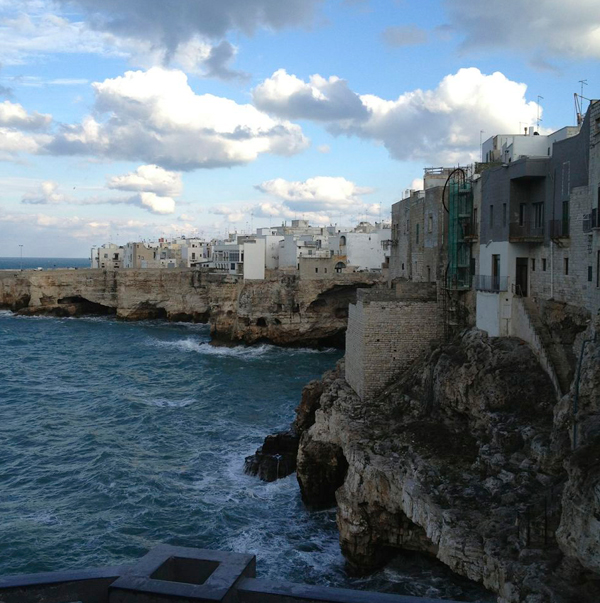
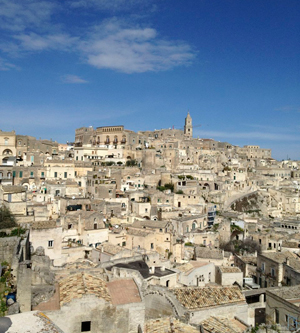
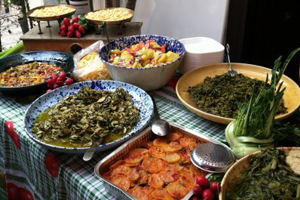
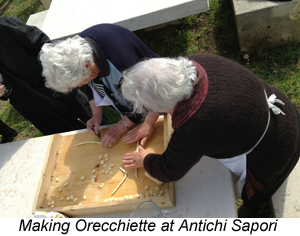
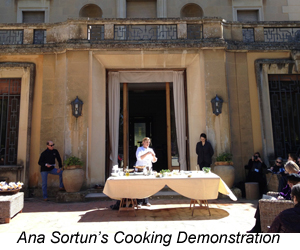
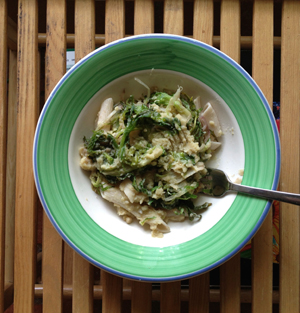




Leave a comment